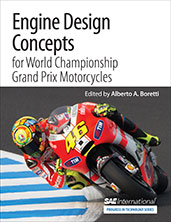Technical Paper
Lean-Burn Stratified Alcohol Fuels Engines of Power Density up to 475 kW/Liter Featuring Super-Turbocharging, Rotary Valves, Direct Injection, and Jet Ignition
2020-09-15
2020-01-2036
Direct injection (DI) and jet ignition (JI), plus assisted turbocharging, have been demonstrated to deliver high efficiency, high power density positive ignition (PI) internal combustion engines (ICEs) with gasoline. Peak efficiency above 50% and power density of 340 kW/liter at the 15,000 rpm revolution limiter working overall λ=1.45 have been report-ed. Here we explore the further improvement in power density that may be obtained by replacing gasoline with ethanol or methanol, thanks to the higher octane number and the larger latent heat of vaporization, which translates in an increased resistance to knock, and permits to have larger compression ratios. Results of simulations are proposed for a numerical engine that uses rotary valves rather than poppet valves, while also using mechanical, rather than electric, assisted turbocharging. While with gasoline, the power density is 410-420 kW/liter, the use of oxygenates permits to achieve up to 475 kW/liter working with methanol.

